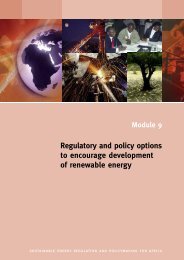Increasing access to energy services in rural areas - REEEP ...
Increasing access to energy services in rural areas - REEEP ...
Increasing access to energy services in rural areas - REEEP ...
You also want an ePaper? Increase the reach of your titles
YUMPU automatically turns print PDFs into web optimized ePapers that Google loves.
MODULE 10: INCREASING ACCESS TO ENERGY SERVICES IN RURAL AREAS<br />
page 10.61<br />
Rural electrification criteria<br />
The criteria for <strong>rural</strong> electrification plann<strong>in</strong>g must be developed through a step-by-step<br />
process. An example process of criteria development is presented here:<br />
Step 1: Identification of national development plan priority <strong>areas</strong><br />
Step 2: First pass technology assessment<br />
Step 3: Project cluster<strong>in</strong>g and identification<br />
Step 4: Project prioritisation<br />
Step 5: Regional equity adjustment<br />
Each of these steps has a specific output <strong>in</strong> order <strong>to</strong> facilitate the development of the <strong>rural</strong><br />
electrification plan for the country. A diagram show<strong>in</strong>g the steps and their outputs is given<br />
<strong>in</strong> figure I.<br />
Step 1:<br />
National development plan priority <strong>areas</strong><br />
The first step <strong>in</strong> the process of select<strong>in</strong>g priority <strong>areas</strong> for electrification is <strong>to</strong> identify<br />
regions that have been prioritized for economic development: these may <strong>in</strong>clude special<br />
development zones etc.<br />
These regions are sometimes laid out <strong>in</strong> a country’s National Development Plan and other<br />
national development plann<strong>in</strong>g documents are worth exam<strong>in</strong><strong>in</strong>g such as agricultural development<br />
plans, poverty eradication action plans, etc. From these k<strong>in</strong>ds of documents<br />
priority regions for electrification can be identified such as regional or district headquarters,<br />
regions with many agricultural projects, <strong>areas</strong> with large <strong>in</strong>dustrial loads and trad<strong>in</strong>g<br />
centres.<br />
In addition <strong>to</strong> this, it is essential <strong>to</strong> <strong>in</strong>tegrate the <strong>rural</strong> electrification plann<strong>in</strong>g with the<br />
transmission and distribution network plann<strong>in</strong>g. This requires close cooperation and coord<strong>in</strong>ation<br />
between the Rural Electrification Agency, the M<strong>in</strong>istry <strong>in</strong> question (usually the<br />
M<strong>in</strong>istry of Energy) and the Transmission and Distribution System Opera<strong>to</strong>r.<br />
Step 2:<br />
First pass technology assessment<br />
The first pass technology assessment is an important output of the process of plann<strong>in</strong>g<br />
<strong>rural</strong> electrification. This will provide a map of the country detail<strong>in</strong>g:<br />
• Current and planned electricity transmission and distribution networks;<br />
• Planned future and potential additional generation capacity;<br />
• Unexploited local resources such as small, m<strong>in</strong>i and micro-hydro sites, as well as solar,<br />
w<strong>in</strong>d and biomass resources.










